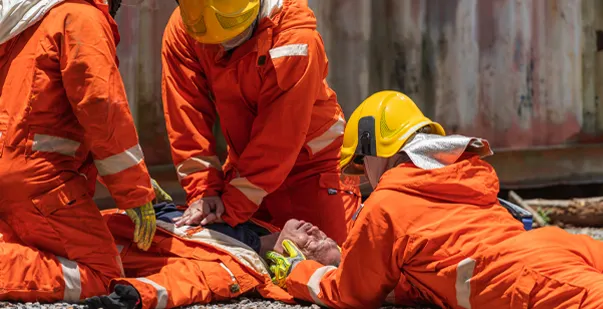Table Of Content(s)
- Types of Environmental Emergencies
- General Steps to Follow for Any Environmental Emergency
- Steps to Follow for Injuries During Environmental Emergencies
- Preparation and Prevention
- After the Emergency: Recovery Steps
- Conclusion
Environmental crises are unplanned, abrupt occurrences that immediately endanger human health, property, and the environment. From man-made emergencies like chemical spills to natural disasters like earthquakes, these events need a quick and deliberate response. The International Disaster Database (EM-DAT) records 399 disasters in 2023 that affected 93.1 million people and caused over $202.7 billion in economic damage.
Being prepared is not just a precaution; it’s a necessity in our ever-changing world. Knowing the steps to follow for environmental emergencies may make all the difference between safety and risk, between minimal damage and catastrophe. But how do you navigate the chaos when disaster strikes? Uncover the vital steps that could save lives.
Master ACLS Now
Get ACLS certified with confidence
Types of Environmental Emergencies
Environmental crises take many different shapes, each offering different risks and difficulties. Good preparation and reaction depend on an awareness of these many forms. Let’s discuss the two basic types of environmental crises that immediately endanger lives.
-
Natural Disasters
Natural disasters are environmental emergencies caused by natural factors. They usually result in great destruction and may strike suddenly or evolve gradually. Examples include earthquakes, storms, floods, tsunamis, wildfires, and volcanic eruptions.
Every calamity has different risks and requires different reaction plans. For example, a storm calls for evacuation or strong shelter-in-place preparations; an earthquake calls for quick cover from falling debris. Natural disasters may rapidly become life-threatening environmental crises, especially when they cause secondary risks like landslides, dam failures, or disease outbreaks.
-
Man-Made Disasters
Man-made disasters are environmental crises caused by human activities or technical breakdowns. They can include chemical spills, industrial accidents, oil spills, nuclear incidents, and large-scale pollution events.
Man-made crises differ from natural ones in that they often release toxic elements, endangering human health and the environment. A chemical factory explosion, for example, can spew toxic gasses into the nearby region and call for quick evacuation and specific cleaning. Similarly, a maritime oil spill may have far-reaching consequences for ecosystems and local economies.
When considering which of the following is considered a life threatening environmental emergency, it’s essential to note that both natural and man-made disasters can pose immediate threats to human life. However, some situations, such as flash floods, significant earthquakes, disastrous chemical releases, and nuclear accidents, are often regarded as the most dangerous owing to their fast start and potential for widespread, instant devastation.
General Steps to Follow for Any Environmental Emergency
Knowing how to respond to an environmental disaster can help to reduce damage and save lives. These broad actions provide a strong basis for efficient response and apply to most crises.
-
Assess the Situation
The first of the steps you should follow for any injury or environmental emergency is to assess the situation carefully. Spend time deciding the kind and extent of the emergency. Is it a natural disaster, such as a flood or earthquake, or a man-made problem, such as a chemical spill? Evaluate the extent of the threat to yourself, others, and the environment.
Search for any risks, including toxic gasses in an industrial disaster or fallen power lines after a storm, that may not be immediately clear-cut. This brief yet exhaustive evaluation will direct your future steps and support wise decision-making.
-
Prioritize Safety
After assessment, the next crucial step for injury or environmental emergency is to prioritize safety. First of all, ensure you are secure; you cannot assist others if you become a victim. If evacuation is essential, proceed calmly and immediately. Help others evacuate if you can do so safely.
If evacuation is not feasible or advised, find cover in a safe area. This might include shifting to higher ground during a flood or sheltering in place after a chemical release. Always do as advised and officially follow the best line of action.
-
Communicate Effectively
Any emergency requires effective communication. Notify appropriate authorities, such as emergency services or environmental agencies, as soon as feasible. Provide them with precise, succinct information about the circumstances.
Your open communication guarantees the appropriate distribution of resources and accelerates reaction times. If you work or live in a public area, cooperate with those engaged in the emergency response. Share facts and cooperate to guarantee everyone’s safety.
-
Contain the Situation
If it is safe, act to stop the emergency from escalating. This is one of the key steps to follow for any injury or environmental emergency to prevent a bad situation from worsening. For instance, in a modest chemical leak, you may utilize absorbent materials to stop the chemical from spreading elsewhere.
Clearing combustible materials away from buildings could assist in stopping the spread of a wildfire. However, never put yourself at risk – leave major containment efforts to trained professionals.
-
Seek Professional Help
The final step in the steps for injury or environmental emergency is to seek professional help. Get professionals on cleaning and remedial action right away. These can call for disaster recovery experts, environmental cleaning companies, or teams of hazardous materials handlers. Use their advice on safety precautions and disinfection very seriously. Professionals have the tools and knowledge to properly and safely manage harmful events.
These steps you should follow for any injury or environmental emergency are general guidelines. Specific crises may need extra or different responses. Learn local emergency protocols and keep updated on the risks in your neighborhood. When a crisis comes, by being ready and following these guidelines, you may assist in safeguarding the environment, people, and yourself.
Read More: CPR vs. BLS Training: What’s the Difference?
Steps to Follow for Injuries During Environmental Emergencies
During an environmental crisis, injuries are common. Knowing how to react can literally save your life. Here are the key steps to follow for injury or environmental emergency situations:
-
Assess the Injury
First, promptly assess the severity of the damage. Look for shock, blood, or fractured bones. Look for less clear-cut injuries like concussions or internal bleeding. Your evaluation will direct your future steps. Call for emergency assistance right once if the damage seems to be life-threatening. Remember that your safety is very important. Ensure the place is secure before seeing the wounded individual so you won’t become a victim, too.
-
Provide First Aid
After evaluation, provide appropriate first aid. This is one of the most critical environmental emergency steps. Use direct pressure on the bleeding wound. Should you suspect a fractured bone, immobilize the affected region to prevent further injury.
Regarding burns, cool the affected area with fresh water. Always give circulation and breathing first priority. If the victim is not breathing, perform CPR if you are certified. Your fast response will allow the individual who is suffering to remain stable until expert aid arrives.
-
Monitor the Victim
Continuous monitoring is vital when considering what steps should you follow for any injury or environmental emergency. Watch closely the state of the wounded individual. Look for changes in consciousness, pain level, or respiration. Assure them of comfort to help avoid shock. If their health worsens, be prepared to change your first-aid strategy. While you wait for emergency services, keep them warm and as cozy as you can. Your continuous focus helps you identify important developments that can call for quick reaction.
Preparation and Prevention
Your coping ability may be much improved by being prepared for an environmental disaster. Here are key steps to follow for environmental emergency preparedness:
Create an Emergency Kit
Building an emergency pack is one of the most important stages in becoming ready for any catastrophe. Stock it with basics like water, nonperishable food, first aid materials, flashlights, and batteries. Add any required medication, important documents, and a battery-powered radio. Remember also things for comfort and personal hygiene.
Check and refresh your kit often to be sure it is not outdated and in excellent shape. If you need to leave or your services are disrupted, a well-stocked emergency pack may keep you and your family going for many days.
Develop a Family Emergency Plan
Coordinated effort during a disaster depends on a family emergency plan. Talk about possible situations and decide on a collective response. Select locations close to your house and in your town or city. Give every family member responsibilities, including who will care for pets or fetch the emergency pack.
Practice your plan regularly so everyone knows what steps to follow for environmental emergency situations. Add communication strategies should family members live apart. A good strategy guarantees everyone responds quickly and safely during an emergency and helps to lower panic.
Stay Informed About Potential Risks in Your Area
In environmental crises, knowledge is indeed power. Find out the types of disasters most likely to strike your region. Follow trustworthy news sources and register for local alert systems. Find community emergency preparations and escape routes.
Know the warning signs of possible calamities, like strange aromas suggesting a chemical leak or increasing water levels. Maintaining knowledge helps you see risks early on and respond appropriately.
Read More: First Aid For An Unconscious Person
After the Emergency: Recovery Steps
The process of recuperation starts after the acute risk passes. The following are the main actions to do in the wake of an environmental disaster:
Return Home Safely
Wait for formal approval to go home before hurrying back. Look for structural damage, gas leaks, or downed electricity lines. Enter cautiously, wearing protective gear if needed. If you smell gas or see sparks, evacuate immediately and seek assistance. Your safety always comes first, even if the primary crisis has passed.
Document Damage
When it’s safe, carefully record all damage. Capture images and videos of impacted objects and surroundings. This documentation is critical for insurance claims and future help programs. Create thorough catalogs of missing or damaged items.
Don’t forget to capture any injuries that occurred during the emergency. Good documentation guarantees the assistance you need and helps speed up the recovery process.
Begin Cleanup and Repairs
Start the cleanup meticulously using safety precautions. Put on protective clothing and know about any risks like mold or polluted water. Sort items into categories: salvageable, unsalvageable, and uncertain. Start with easy tasks, including clearing trash or drying out damp spaces. For major repairs, consult professionals to ensure safety and proper restoration.
Remember that certain stages of environmental disaster recovery may need specialist assistance, particularly for building damage or hazardous substance cleaning.
Final Thoughts
Environmental crises may hit anywhere at any moment. Being ready is not just wise—it’s really necessary. Remember the key steps to follow for environmental emergency situations: assess, prioritize safety, communicate, contain, and seek help. These acts help to reduce damage and preserve lives. Build a family plan, assemble an emergency pack, and keep updated on local dangers.
Stay calm and use these guidelines during a crisis. Return home safely after the incident, record damage, and begin meticulously with clean-up. Learning these techniques and other life saving skills can help you to meet any environmental obstacle. When nature or accidents threaten your safety and well-being, your preparedness could make all the difference.







